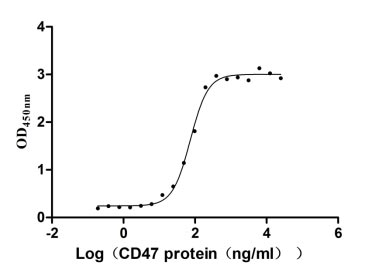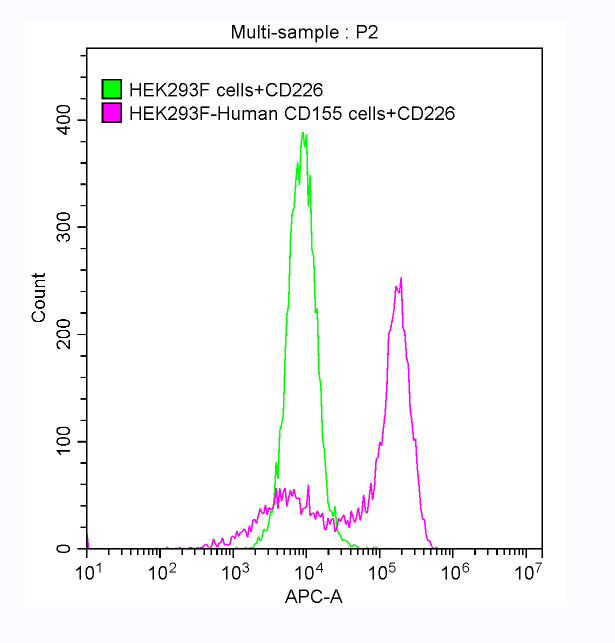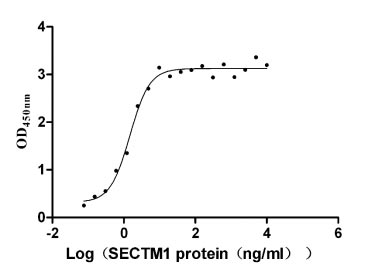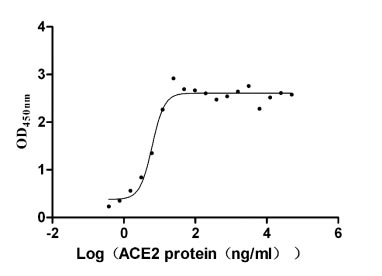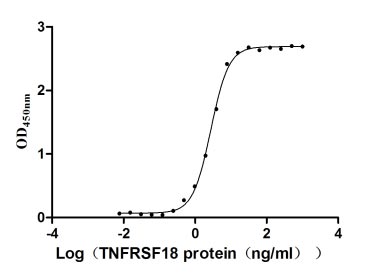Recombinant Rat Potassium voltage-gated channel subfamily D member 2 (Kcnd2), partial
-
中文名称:大鼠Kcnd2重组蛋白
-
货号:CSB-YP720549RA1
-
规格:
-
来源:Yeast
-
其他:
-
中文名称:大鼠Kcnd2重组蛋白
-
货号:CSB-EP720549RA1
-
规格:
-
来源:E.coli
-
其他:
-
中文名称:大鼠Kcnd2重组蛋白
-
货号:CSB-EP720549RA1-B
-
规格:
-
来源:E.coli
-
共轭:Avi-tag Biotinylated
E. coli biotin ligase (BirA) is highly specific in covalently attaching biotin to the 15 amino acid AviTag peptide. This recombinant protein was biotinylated in vivo by AviTag-BirA technology, which method is BriA catalyzes amide linkage between the biotin and the specific lysine of the AviTag.
-
其他:
-
中文名称:大鼠Kcnd2重组蛋白
-
货号:CSB-BP720549RA1
-
规格:
-
来源:Baculovirus
-
其他:
-
中文名称:大鼠Kcnd2重组蛋白
-
货号:CSB-MP720549RA1
-
规格:
-
来源:Mammalian cell
-
其他:
产品详情
-
纯度:>85% (SDS-PAGE)
-
基因名:Kcnd2
-
Uniprot No.:
-
别名:Kcnd2; Potassium voltage-gated channel subfamily D member 2; RK5; Shal1; Voltage-gated potassium channel subunit Kv4.2
-
种属:Rattus norvegicus (Rat)
-
蛋白长度:Partial
-
蛋白标签:Tag type will be determined during the manufacturing process.
The tag type will be determined during production process. If you have specified tag type, please tell us and we will develop the specified tag preferentially. -
产品提供形式:Lyophilized powder
Note: We will preferentially ship the format that we have in stock, however, if you have any special requirement for the format, please remark your requirement when placing the order, we will prepare according to your demand. -
复溶:We recommend that this vial be briefly centrifuged prior to opening to bring the contents to the bottom. Please reconstitute protein in deionized sterile water to a concentration of 0.1-1.0 mg/mL.We recommend to add 5-50% of glycerol (final concentration) and aliquot for long-term storage at -20℃/-80℃. Our default final concentration of glycerol is 50%. Customers could use it as reference.
-
储存条件:Store at -20°C/-80°C upon receipt, aliquoting is necessary for mutiple use. Avoid repeated freeze-thaw cycles.
-
保质期:The shelf life is related to many factors, storage state, buffer ingredients, storage temperature and the stability of the protein itself.
Generally, the shelf life of liquid form is 6 months at -20°C/-80°C. The shelf life of lyophilized form is 12 months at -20°C/-80°C. -
货期:Delivery time may differ from different purchasing way or location, please kindly consult your local distributors for specific delivery time.Note: All of our proteins are default shipped with normal blue ice packs, if you request to ship with dry ice, please communicate with us in advance and extra fees will be charged.
-
注意事项:Repeated freezing and thawing is not recommended. Store working aliquots at 4°C for up to one week.
-
Datasheet :Please contact us to get it.
相关产品
靶点详情
-
功能:Voltage-gated potassium channel that mediates transmembrane potassium transport in excitable membranes, primarily in the brain, but also in rodent heart. Mediates the major part of the dendritic A-type current I(SA) in brain neurons. This current is activated at membrane potentials that are below the threshold for action potentials. It regulates neuronal excitability, prolongs the latency before the first spike in a series of action potentials, regulates the frequency of repetitive action potential firing, shortens the duration of action potenti...显示更多
-
基因功能参考文献:
- Study revealed that ERK5 signaling promotes phosphorylation of Kv4.2 and inhibits the inactivation of the A-type current for the enhancement of membrane excitability in PC12 cells. PMID: 29996472
- Results showed: (i) seizures are associated with more brain damage and neuronal damage is not the major contributor of seizure generation in ischemic rats; (ii) the expression of IA channel subunit Kv4.2 is selectively reduced in ischemic rats with spontaneous behavioral seizures; (iii) The reduction of Kv4.2 may be associated with the long-term increased seizure susceptibility of ischemic rats. PMID: 27259067
- NMDA reduced both currents in a concentration-dependent manner, whereas there was no significant impact on the currents when perfused with MK-801. MDD rats exhibited significantly more fibrosis areas in heart tissue and reduced expression of Kv4.2, Kv4.3, and Cav1.2. PMID: 28566490
- Data show that voltage-gated K+ channel Kv4.2 as a target gene of microRNA miR-223-3p. PMID: 27322747
- 17betaestradiol suppresses epileptiform activity by enhancing Kv4.2-mediated transient outward potassium currents in primary hippocampal neurons. PMID: 26179130
- The study provides the first piece of evidence for the role of H2S in regulating Ito potassium channels and also the specific motif in an ion channel labile for H2S regulation. PMID: 25756524
- The rsults of this study suggested that the reduction of Kv4.2 expression could contribute to the development of postischemic seizures in hyperglycemia. PMID: 25043828
- Subunit counting by single-molecule imaging revealed that the bound number of KChIP4 in each Kv4.2.KChIP4 complex was dependent on the expression level of KChIP4. PMID: 24811166
- we show for the first time that Kv4.2 channels can self-organize to locally alter the excitability of the dendrite in the absence of any signaling resulting from synaptic potentiation. PMID: 24404150
- This study demonistrared that the expression and function of Kv4.2 channels in neurons of the rat bed nucleus of the stria terminalis. PMID: 24037673
- Neuritin activates insulin receptor pathway to up-regulate Kv4.2-mediated transient outward K+ current in rat cerebellar granule neurons PMID: 23066017
- The expression densities of Kv4.2 and Kv4.3 channels are significantly higher in type I neurons than in type II neurons. PMID: 22245500
- This study showed that Significant differences in Kv4.2 and Kv4.3 mRNA levels in conditioned rats. and up regulation in the brain. PMID: 22700470
- Traumatic brain injury causes a transient downregulation of the kv4.2 channel subunit in hippocampal CA1 neurons, which is associated with hyperexcitability in the post-traumatic hippocampus and in turn leads to seizures and epilepsy. PMID: 21895522
- These results indicate that distance-dependent Kv4.2 mobility is regulated by activity-dependent phosphorylation of Kv4.2 by PKA. PMID: 21472817
- Differential dorso-ventral distributions of Kv4.2 and HCN proteins confer distinct integrative properties to hippocampal CA1 pyramidal cell distal dendrites. PMID: 22511771
- Data suggest that the increase in current along the proximo-distal axis of pyramidal cell dendrites cannot be solely explained by a corresponding increase in Kv4.2 channel number. PMID: 22098631
- Immunocytochemistry indicated that protein expression for Kv4.2 increased between 1 wk and 4-5 wk of age. PMID: 21451062
- Collectively, these results indicate that Kv4.2 mRNA levels are regulated in response to synaptic activity, and this phenomenon may be the mechanism underlying the homeostasis of Kv4.2 protein on dendritic surfaces. PMID: 21511008
- The K(V)4.2/K(V)4.3 channel forms a supramolecular complex with PKA through AKAP100 and is attached to caveolae by interacting with caveolin-3. PMID: 20224290
- Results indicate that Kv4.2 channels must regulate synaptic integration and plasticity through another mechanism in addition to their regulation of synaptic NR2 subunit composition. PMID: 20920553
- AKAP79/150 provides a platform for dynamic protein kinase A regulation of Kv4.2 expression, fundamentally impacting CA1 excitability. PMID: 21273417
- The dendritic localization of Kv4.2 mRNAs might regulate the dendritic surface level of Kv4.2 channels and synaptic plasticity. PMID: 21034530
- results show that the glutamate-induced downregulation of Kv4.2 is mediated by NR2B-containing NMDA receptors and is linked to proteolysis by calpain, which might contribute to the development of neuronal hyperexcitability and neurodegenerative diseases. PMID: 19857555
- Kv4.2 overexpression counteracted cardiac hypertrophy-related changes in isolated electrically and chemically stimulated cardiomyocytes PMID: 12403671
- An evolutionarily conserved dileucine motif is necessary for dendritic targeting of potassium channel Kv4.2 and is sufficient to target the axonally localized channels Kv1.3 and Kv1.4 to the dendrites PMID: 12592409
- autocrine release of angiotensin II and endothelin 1 in diabetic and hypothyroid conditions attenuates K(+) currents by suppressing synthesis of potassium channels, the Kv4.2 component here, with effects mediated by protein kinase C-epsilon PMID: 12626328
- zinc-mediated tetramerization also is a physiologically important event for full-length functional channel formation. PMID: 12754210
- crystal structure of the Kv4.2 T1 domain PMID: 12835418
- Kv4.2 plays an essential role in producing the A-type current in striatal cholinergic interneurons during the entire course of postnatal development. PMID: 12843309
- Increased numbers and altered distribution of Kv4.2 channels at the cell surface are primarily the result of reorganization of the actin cytoskeleton. PMID: 14551056
- Hippocampal dentate granule and CA3 pyramidal cells and cerebellar granule cells express high levels of colocalized Kv4.2 and Kv4.3 which coassociate with KChIPs 1-4. These channels may play a major role as modulators of somatodendritic excitability. PMID: 15356203
- Zinc(2+)-less potassium voltage gated(Kv4.2) channels expressed with KChIP3 protein demonstrate several distinct kinetic changes in channel gating PMID: 15485870
- DPP10 modulates Kv4.2-mediated A-type potassium channels PMID: 15671030
- A-type potassium channels containing Kv4.2 play a critical role in regulating postsynaptic excitability at the cerebellar mossy-fiber/granule cell synapse. PMID: 15736227
- In conclusion, the native neuronal subthreshold A-type channel is probably a macromolecular complex formed from Kv4 and a combination of both KChIP and DPL proteins. PMID: 16123112
- These results point to Kv4.2 as the major contributor to the A-current in hippocampal CA1 neurones. PMID: 16141270
- the data of this study suggest that Kv4.2 subunits could be involved in pain modulation. PMID: 16176357
- Study shows the molecular basis of A type current increase in central neurons and that endogenous production of Amyloid beta is important in the modulation of Kv4.2 and Kv4.3 subunit expression. PMID: 16271805
- Data support the hypothesis that expression of A-type K(+) channel alpha subunits Kv4.2 and Kv4.3 may protect somatic motoneurons, and possibly also interneurons, from naturally occurring cell death during developmental selection. PMID: 16553778
- Our results establish a specific role for native Kv4.2 transcripts in forming and maintaining I(SA) current at characteristic levels in hippocampal pyramidal neurons PMID: 17026528
- Data show that in the Kv4.2+KChIP3+DPP10 channel complex, all DPP10 variants accelerate channel gating kinetics; however, the splice variant DPP10a produces uniquely fast inactivation kinetics that accelerates with increasing depolarization. PMID: 17475505
- Coexpression of Kv4.2 with STX1A resulted in a reduction of Kv4.2 current amplitude; caused a depolarizing shift of the steady-state inactivation curve; enhanced the rate of current decay; accelerated the rate of recovery from inactivation. PMID: 17725325
- Taken together, our results suggest that excitatory neurotransmission affects neuronal excitability via the regulation of the K+ channel membrane translocation. PMID: 18088376
- These results demonstrate a glutamate-induced alteration of Kv4.2 channels in cultured hippocampal neurons, which might be involved in activity-dependent changes of neuronal excitability and synaptic plasticity. PMID: 18363830
- Evidence for highly non-uniform subcellular distribution of A-type Kv4.2 potassium channels predicts their involvement in novel forms of intercellular communication in the olfactory pathway. PMID: 18371079
- Increased extracelluar signal-regulated kinase (ERK) phosphorylation of Kv4.2 and decreased levels of Kv4.2 channels in the post-synaptic membrane of hippocampal neurons contribute to hyperexcitability during status epilepticus. PMID: 18513371
- Data suggest that the expression of Kv4.2 channels in the failing heart is redox-regulated by the thioredoxin system. PMID: 18515646
- Interaction between transcription factors Iroquois proteins 4 and 5 controls cardiac potassium channel Kv4.2 gene transcription across the left ventricular wall of rodent hearts. PMID: 18815185
- mRNA expression for Kcnd2 and Kcne2 was significantly reduced in diabetic rats which may underlie delayed propagation of electrical activity in the ventricular myocardium PMID: 19267230
收起更多
-
亚细胞定位:Cell membrane; Multi-pass membrane protein. Cell projection, dendrite. Cell junction, synapse. Perikaryon. Cell junction, synapse, postsynaptic cell membrane. Cell projection, dendritic spine. Cell membrane, sarcolemma. Cell junction. Membrane, caveola.
-
蛋白家族:Potassium channel family, D (Shal) (TC 1.A.1.2) subfamily, Kv4.2/KCND2 sub-subfamily
-
组织特异性:Detected in brain cortex, hippocampus, dentate gyrus, thalamus and cerebellum. Detected in neurons from the primary visual cortex. Detected in the supraoptic nucleus in hypothalamus, in hippocampus and the habenular nucleus of the thalamus. Detected in th
-
数据库链接:
KEGG: rno:65180
STRING: 10116.ENSRNOP00000039227
UniGene: Rn.87841


